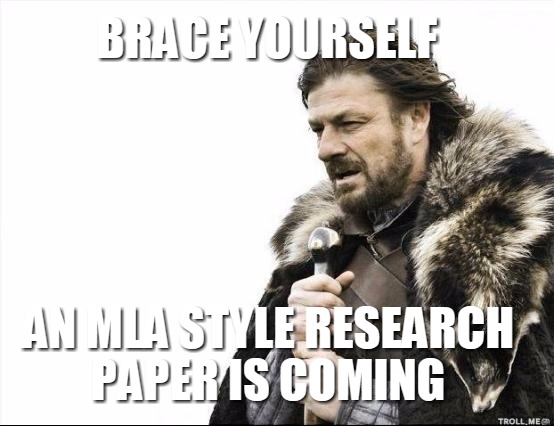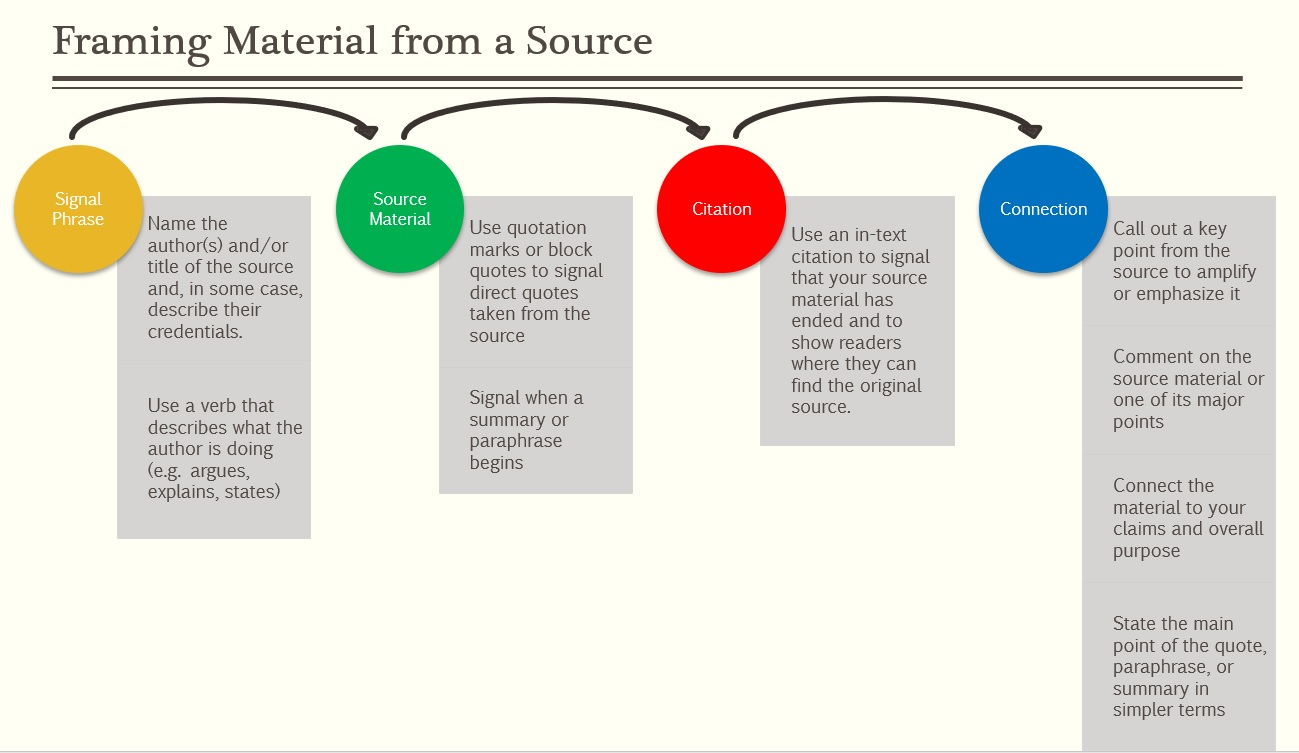35
By the end of this chapter, you will be able to:
- Paraphrase and summarize source information. (GEO 2; SLO 2)
When paraphrasing and summarizing, you are putting someone else’s ideas into your own words. In some situations, using a paraphrase or summary is preferable to using a quote. Using too many quotations can make a text look choppy and might lead the reader to think that you are just stitching together passages from other people’s works. Paraphrasing allows you maintain the tone and flow of your writing.
Paraphrasing
To paraphrase means to take a piece of text- aka someone else’s ideas, opinions, examples, etc.-and put it in your own words. When you paraphrase, you do not leave any details out. In fact, paraphrases are often longer than the original piece of text! Attribution stills needs to be given to the author because the idea behind the paraphrase is not yours. Include an in-text citation with the author’s last name and page number. Generally, paraphrasing is better than directly quoting!
How to Paraphrase:
- Read and reread the text for understanding.
- Put the source away.
- Write key points that you remember without looking at the source. You do not even want to use the same sentence format or structure. Generally, you are not going to paraphrase a whole text — just a specific part of the text important to your essay or speech.
- Compare the paraphrase to the original to make sure you did not miss any key information OR plagiarize by including unique words.
- Quote any exact borrowings. Maybe it is just one unique word—put quotation marks around those borrowed words if you cannot come up with your own or you think the original is essential.
- Record the source on your Works Cited page.
Paraphrase Example
Original text: “Dogs are not colorblind. They are able to detect color in their vision, just not as vividly as humans” (“Dog Facts”). Source: AnimalPlanet.com
Unacceptable paraphrase: Contrary to popular belief, dogs are not colorblind. They are able to notice color, simply not as brightly as humans (“Dog Facts”).
Acceptable paraphrase: Colorblindness, according to AnimalPlanet.com, is not an adequate word to describe a dog’s eyesight. In fact, dogs are able to perceive the same colors as humans but only, in a more dull manner (“Dog Facts”).
Summarizing
A summary is a shortened version of the original text that gives an overview of the main points. It should be written in third-person point of view and in your own words. It needs to be clear to someone who hasn’t read the original text. The main points you present should follow (in most cases) the same order as the original text. It should include attribution to the author and include the title of the original text (if they have not already been stated in the essay). Use formal language for summaries. Lastly, remember to include a complete entry for the source on your Works Cited.
A summary does not contain your personal opinions and ideas. You must be objective and present only the author’s points, even if you disagree. Summaries should not use direct quotes (in most cases). Summaries should not use specific details such as percentages, numerical data, examples, interpretations, dates, figures.
Summary Writing Methods
 Read all texts through one time before highlighting anything. This way you can ask yourself when you are done “What is the one main point the author wants me to understand?”
Read all texts through one time before highlighting anything. This way you can ask yourself when you are done “What is the one main point the author wants me to understand?”
Fiction Method of Summarization
Use the formula “Somebody… Wanted …But… So… Then…” adding detail to your sentences as you go.
Nonfiction Methods of Summarization
IPOP: Important Points Only Please. Read the text highlighting the main points. Main points are typically found at the beginning of paragraphs. Remember to leave out specifics.
Heuristics (Who, What, When, Where, Why, and How): Read the text highlighting all of these elements. However, sometimes these elements are implied and not directly stated.
Section-by-Section: Summarize each sub-section of the text in a few words or a sentence. At each subsection weave the previous summaries into the current summary.
Why summarize if you can directly quote?
There are three basic reasons why it is important to summarize:
- Directly quoting limits your learning. By summarize the main ideas into your own words, you are going to understand the information better. As an added bonus, your teacher will like your essay more.
- The original text was not written for the same audience you are writing for. Changes need to be made.
- It helps in avoiding plagiarism.
Differences Between Paraphrasing and Summarizing
- A paraphrase handles only a portion of the original text, while a summary often covers its entire content.
- A paraphrase usually follows the organization of the original source, while a summary reorganizes the content to highlight the major points.
- A paraphrase is usually about the same length or a little shorter than the original text.
- A paraphrase looks through the text to convey what the author is saying, but summaries can also look at the text to explore an author’s strategies, style, reasoning, and other choices.
Providing Context for Your Sources
Whether you use a direct quotation, a summary, or a paraphrase, it is important to distinguish the original source from your ideas, and to explain how the cited source fits into your argument. While the use of quotation marks or parenthetical citations tells your reader that these are not your own words or ideas, you should follow the quote with a description, in your own terms, of what the quote says and why it is relevant to the purpose of your paper. You should not let quoted or paraphrased text stand alone in your paper, but rather, should integrate the sources into your argument by providing context and explanations about how each source supports your argument.
Sources that are not properly integrated into your paper are like “bricks without mortar: you have the essential substance, but there’s nothing to hold it together, rendering the whole thing formless,” as Matt Smith wrote in “Putting It All Together: Thesis Synthesis.”
Framing Paraphrases and Summaries
Your readers need to see the boundaries between your work and the material you are using from your sources. To help your readers identify these boundaries, you should frame your quotations, paraphrases, and summaries by using signal phrases, citing sources, and making connections to your own writing. Refer to Chapter 22: Source Integration for more information on framing source material.
- Signal Phrase: A signal phrase indicates where the source material comes from. The words “as” and “in” are often at the heart of a signal phrase (e.g. “As Gladwell argues,” “In his article, Gladwell states”).
- Source Material: If you are directly quoting a source, this information should be separated from your own words with quotation marks to differentiate which words came from the source and which are your own.
- Citation: An in-text citation directs your readers to the original source. In MLA Style, a parenthetical reference is used to cite the source.
- Connection: When you connect the source’s ideas to your own, you will make it clear how the source material fits in with your own statements and claims.

Source information expressed in the writer/researcher's own words, usually to achieve greater clarity.
The brief form of a source reference that included the text of an essay.
In MLA Style, the bibliography (list of sources used) is referred to as the Works Cited page.
A brief statement or account of the main points of a source, written by the writer/researcher.
A discovery tool that helps you ask insightful questions or follow a specific pattern of thinking.

